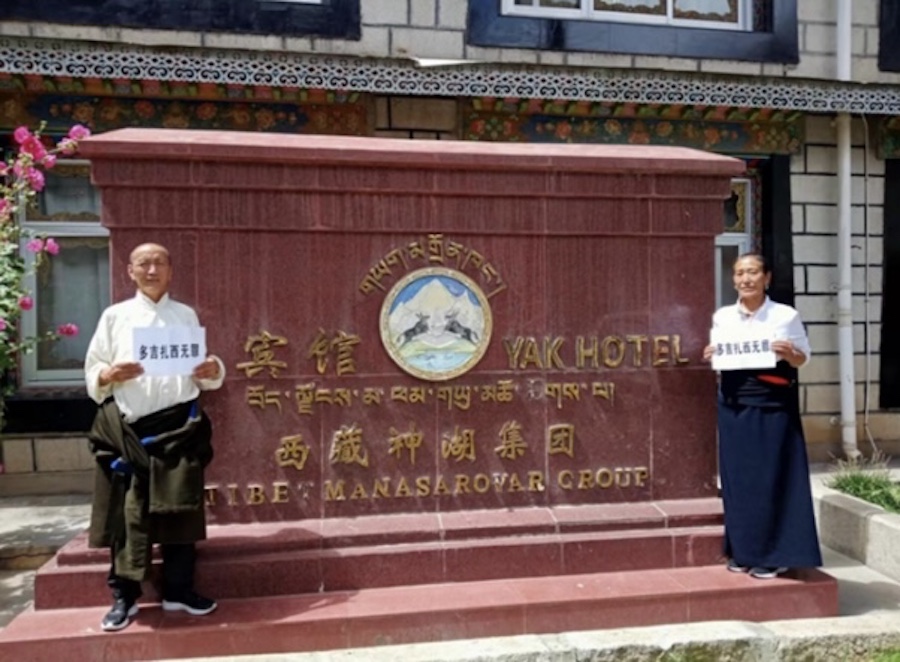By Venkatesan Vembu
 LHASA – Outside the living-room window of Yixiqu Zhen’s showcase home near Lhasa’s Jokhang monastery, a caged bird trills a morning tune.
LHASA – Outside the living-room window of Yixiqu Zhen’s showcase home near Lhasa’s Jokhang monastery, a caged bird trills a morning tune.
It doesn’t sound quite like a carefree song of freedom, more like a well-rehearsed Ode to a Harmonious Society and Peaceful Development, and every note of the birdsong hangs heavily in the air.
Inside the room, as Zhen’s wife scurries about serving changamu, or sweet tea made of yak milk, the 63-year-old retired factory worker sings a familiar tune.
All around them are symbols of Tibetan middle-class affluence: a colour television, a hi-fi system, ornate woodwork panels that glisten in the morning light, an exquisitely embroidered tapestry of the Potala Palace… The Zhens have manifestly made it good since the Chinese “liberation” of Tibet in the 1950s.
“Life has improved beyond our wildest dreams,” trills Zhen, with barely a glance at our Chinese handlers who hover in the background. His two children are civil servants, each earning a salary in excess of 1,000 yuan a month, which puts the family in the upper-middle income category in Lhasa’s transitional economy.
Today, Zhen and his wife lead a life that’s centred around the Jokhang monastery, the 7th century Buddhist temple in Lhasa.
 Yet, Zhen’s cultivated equanimity slips momentarily when he’s asked for his recollections of Lhasa prior to 1959, when the Dalai Lama fled the Potala Palace for India following a failed uprising against Chinese rule.
Yet, Zhen’s cultivated equanimity slips momentarily when he’s asked for his recollections of Lhasa prior to 1959, when the Dalai Lama fled the Potala Palace for India following a failed uprising against Chinese rule.
At first, Zhen admits to remembering nothing of those times: when this claim gives rise to expressions of incredulity (after all, he was 16 in 1959) his memory is sufficiently revived for him to recall that Lhasa’s ragged roads were full of grubby buildings and wandering beggars… Selective amnesia about pre-1959 Tibet appears to be a common-enough affliction in Lhasa today; so marked is it that in some cases it assumes the characteristics of a societal denial of history. Visiting the Potala Palace, the winter palace of the Dalai Lama, one comes across other manifestations of this incapacity — or unwillingness — to reconcile contentious events in history.
At the Potala today, there are few visual reminders of the 14th and current Dalai Lama, whom the Chinese government has variously branded an “anti-national” and a “separatist” for his advocacy of “real autonomy” for Tibet. Qiangba Gesang, who oversees the administration of the palace today, hails from a family of nobles who were on top of the social hierarchy in the pre-1950s feudal Tibet, which was characterised by serfdom. As someone who had access to the Potala when the (then) young Dalai Lama resided in it, his first-person account of life in the palace could have served as an important contribution to narrated folk history of those times. Yet, when he is asked to share his unique insights as a societal observer, Gesang is less than enthusiastic. The Potala, he emphasises, is not a place of worship, and no religious activities of any sort take place there. Even so, it is hard to overlook the centrality of the Potala as a spiritual pivot for lay Tibetans and the obvious manifestations of piety all around the Potala palace.
All along the roads that surround Potala, including the arterial Beijing Road, even today Tibetans offer prayers to the palace. It is the surest sign that memories of another day, when the Tibetan people’s “god-king” ruled, linger in some minds.
Crowds gather on Lama visit rumours
Last month saw another manifestation of the spiritual hold that the Dalai Lama appears to have on Tibetan Buddhists even when he’s in exile. A group of Tibetan Buddhists — upto 10,000 by some estimates — gathered at the Kumbum Monastery in Amdo region of Qinghai province last month after a rumour surfaced that the Dalai Lama would visit the area.
The rumour proved unfounded, but the gathering holds pointers to the continued sway that the spiritual leader holds over the Tibetan people, despite officials’ claims to the contrary. The Chinese government has branded the Dalai Lama a ‘splitist’ and has forbidden him from entering Tibet, which he fled for India in 1959.









